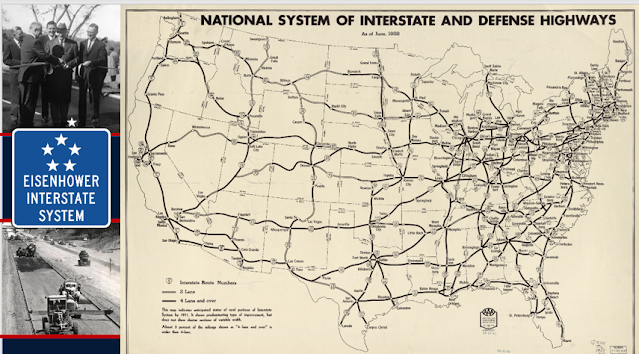Today is President’s Day. Thanks to Kansas native President
Dwight D. Eisenhower, we have a lot to be proud of when it comes to our state’s
interstate systems.
 |
| 34th U.S. President, Dwight D. Eisenhower |
In June 1956, Eisenhower signed the Federal-Aid Highway Act and on
Nov. 14 of that same year, Kansas opened the first section of interstate in
the U.S., just west of Topeka.
All great ideas need inspiration. Eisenhower’s came when, as a young Lieutenant
Colonel, he joined a 1919 military cross-country convoy. The journey began
after a dedication of a temporary monument in Washington, D.C.: The Zero
Milestone Marker, a designated point where the U.S. road system begins.
 |
The Zero Milestone Marker soon after its dedication in 1923. Photo source: FHWA.dot.gov
|
The U.S. Army dispatched a military convoy of 60 trucks and more
than 200 men to cross the country. Accounts from the time show the convoy had to deal with vehicles stuck in mud and
experiencing failing infrastructure across the route.
After two months and 3,200 miles, the convoy
pulled into San Francisco. In a formal report of the trip, Eisenhower said the
trip had been difficult: “Extended trips by trucks through the middle western
part of the United States are impracticable until roads are improved and then
only a light truck should be used on long hauls.”
 |
| During the 1919 transcontinental convoy, west of Grand Island, Nebraska, soldiers use a winch to pull a Class B truck out of a ditch. Lt. Col. P. V. Kieffer surveys the scene. Source: Eisenhower Library |
While it would be another 37 years before
Eisenhower could become the founder of the interstate system, he cited this
journey – and seeing in person the German Autobahn – as inspiration for
improving the nation’s roads.
“…after seeing the autobahns of modern Germany
and knowing the asset those highways were to the Germans, I decided, as
President, to put an emphasis on this kind of road building,” Eisenhower said.
“When we finally secured the necessary congressional approval, we started the
41,000 miles of super highways that are already proving their worth. This was
one of the things that I felt deeply about, and I made a personal and absolute
decision to see that the nation would benefit by it. The old convoy had started
me thinking about good, two-lane highways, but Germany had made me see the
wisdom of broader ribbons across the land.” (Reprinted from Federal Highway
Administration publication.)
Officially dedicated in 1923, the Zero Milestone Marker now stands on the South
Lawn of the White House. While roads don’t all begin and end in Washington, D.C., as the small monument suggests, the reason behind its creation rings true
today: America’s road systems connect us and we all depend on quality
infrastructure to thrive. Kansas’ own Dwight D. Eisenhower helped make it
happen.
 |
The Zero Milestone Marker stands on the South Lawn of the White House.
|





No comments:
Post a Comment